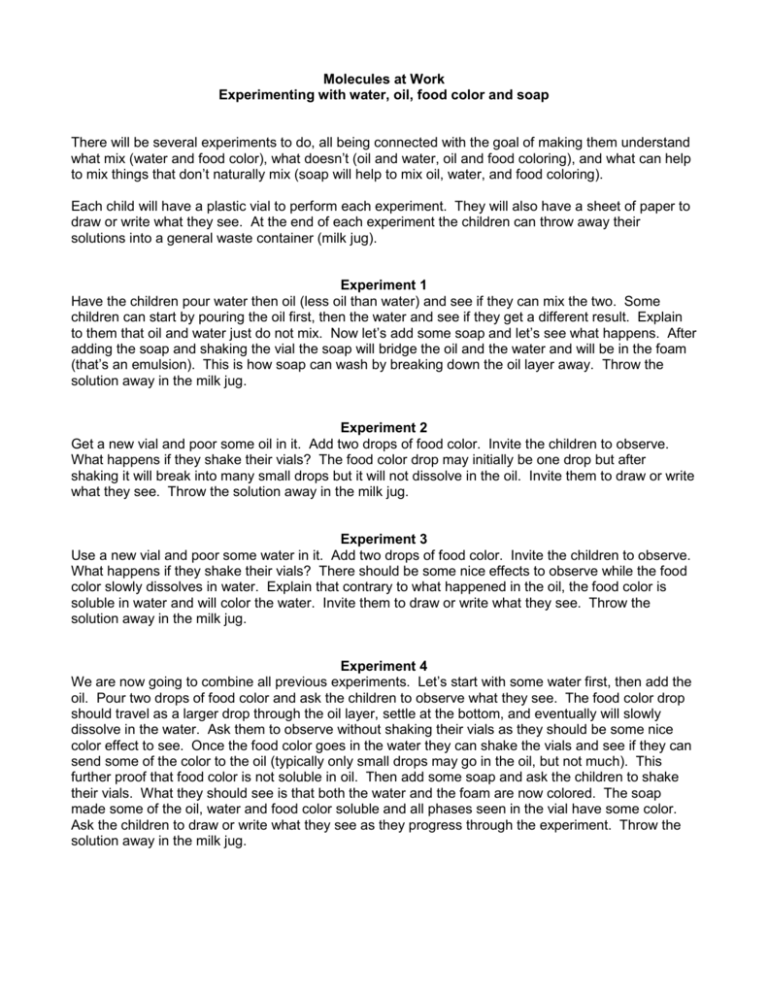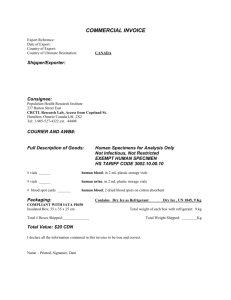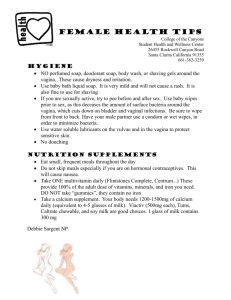Molecules at work
advertisement

Molecules at Work Experimenting with water, oil, food color and soap There will be several experiments to do, all being connected with the goal of making them understand what mix (water and food color), what doesn’t (oil and water, oil and food coloring), and what can help to mix things that don’t naturally mix (soap will help to mix oil, water, and food coloring). Each child will have a plastic vial to perform each experiment. They will also have a sheet of paper to draw or write what they see. At the end of each experiment the children can throw away their solutions into a general waste container (milk jug). Experiment 1 Have the children pour water then oil (less oil than water) and see if they can mix the two. Some children can start by pouring the oil first, then the water and see if they get a different result. Explain to them that oil and water just do not mix. Now let’s add some soap and let’s see what happens. After adding the soap and shaking the vial the soap will bridge the oil and the water and will be in the foam (that’s an emulsion). This is how soap can wash by breaking down the oil layer away. Throw the solution away in the milk jug. Experiment 2 Get a new vial and poor some oil in it. Add two drops of food color. Invite the children to observe. What happens if they shake their vials? The food color drop may initially be one drop but after shaking it will break into many small drops but it will not dissolve in the oil. Invite them to draw or write what they see. Throw the solution away in the milk jug. Experiment 3 Use a new vial and poor some water in it. Add two drops of food color. Invite the children to observe. What happens if they shake their vials? There should be some nice effects to observe while the food color slowly dissolves in water. Explain that contrary to what happened in the oil, the food color is soluble in water and will color the water. Invite them to draw or write what they see. Throw the solution away in the milk jug. Experiment 4 We are now going to combine all previous experiments. Let’s start with some water first, then add the oil. Pour two drops of food color and ask the children to observe what they see. The food color drop should travel as a larger drop through the oil layer, settle at the bottom, and eventually will slowly dissolve in the water. Ask them to observe without shaking their vials as they should be some nice color effect to see. Once the food color goes in the water they can shake the vials and see if they can send some of the color to the oil (typically only small drops may go in the oil, but not much). This further proof that food color is not soluble in oil. Then add some soap and ask the children to shake their vials. What they should see is that both the water and the foam are now colored. The soap made some of the oil, water and food color soluble and all phases seen in the vial have some color. Ask the children to draw or write what they see as they progress through the experiment. Throw the solution away in the milk jug. Atoms and electrons at work Experimenting with static electricity Experiment Have the children tear apart small pieces of paper (they should be good at that). Give them one of the small plastic square or one of the ruler and tell them to touch the paper with the plastic square or ruler. The paper shouldn’t stick to the plastic. Now ask them to rub the plastic against their pants or shirt. That will work especially well if they were synthetic fabric. Now if they approach the plastic near the small piece of paper, the paper should jump or stick to the plastic. It should be fun for them to repeat the experience several times. The explanation of this simple experiment lays in the structure of atoms. They are made of a nucleus bearing a positive charge and of electrons bearing a negative charge. Overall the atom is neutral (zero net electrical charge). By rubbing electrons from one material are transfered to the other. In the end the plastic part now bears a small electrical charge that can affect the atoms of the paper. The atoms of the paper react by displacing electrons in the paper. Opposite electrical charges in the plastic and paper attract each other, making the two materials stick to each other. This is a simple experiment performed 2,600 years ago by Thales of Miletus and was the first experimental evidence of electricity though it wasn’t understood as such. The notion of atom (indivisible matter) was introduced 150 years later by Democritus. By the way when combing hair with a plastic brush or comb hair becomes electrostatic in particular in dry atmosphere, as electrons are transferred between the hair and the plastic brush/comb.





